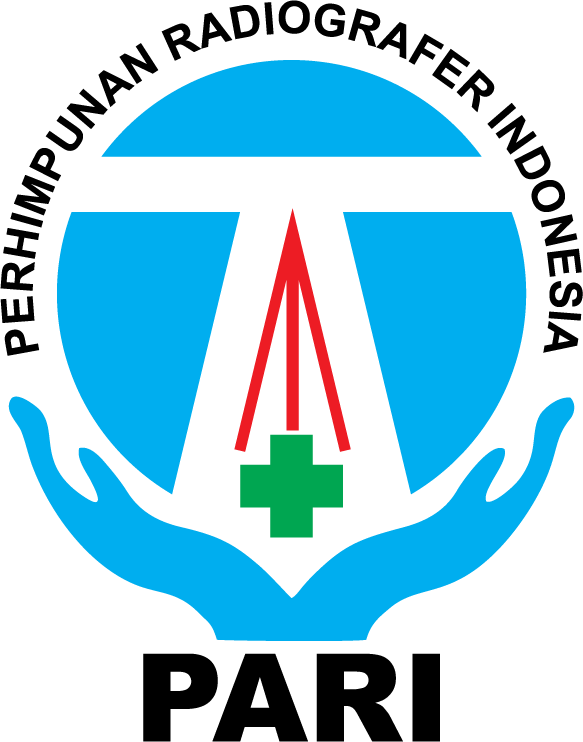Terapi Radiasi Eksternal dengan Metode Hypofractionated pada Kanker payudara Post Breast Conserving Surgery di Instalasi Onkologi Radiasi Rumah Sakit Indriati Solo Baru: Studi Kasus
Abstract
Background: Radiotherapy is one method of cancer treatment that uses radiation to destroy cancer cells. Radiation dose delivery is done gradually through a process called fractionation, which is divided into conventional and hypofractionated fractions. In the radiation oncology installation of the new Indriati Solo Hospital, some breast cancer patients have received treatment with the hypofractionated method, while the majority still use the conventional fraction method. The hypofractionated method aims to reduce the number of treatment sessions by increasing the dose in each fraction with outcomes comparable to conventional fractions.
Methods: This research method is descriptive qualitative with a case study approach. The study involves breast cancer patients post-Breast Conserving Surgery (BCS), Data were gathered through interviews with radiation oncologists, radiotherapists, and medical physicists, along with direct observations and patient record analysis The collected data were analyzed descriptively to evaluate the application and effectiveness of the hypofractionated method.
Results: The results showed that the use of hypofractionated can shorten OTT (Overall Treatment Time), as well as better side effects than conventional fractions, and effectively reduce the number of queues of radiotherapy patients. In conclusion, the use of the hypofractionated method is very effective and recommended for radiotherapy treatment in breast cancer.
Conclusions: Hypofractionated radiotherapy for breast cancer patients at Indriati Solo Baru has proven effective in reducing OTT and patient queues, with outcomes comparable to conventional fractionation. Further research is needed to assess long-term benefits, including quality of life, recurrence rates, cost-effectiveness, and dose distribution, particularly in high-volume healthcare settings. Hypofractionated radiotherapy is a promising alternative.
Keywords
Full Text:
PDFReferences
Aditya B.K, E., & Gondhowiardjo, S. A. (2013). Hipofraksinasi Pada Kanker Payudara Stadium Dini. Jurnal of the Indonesian Radiation Oncology Society, 4 (2)(2), 53–60.
Bhattacharyya, T., Mahajan, R., Ghoshal, S., Yadav, B., & Rai, B. (2015). Hypofractionated radiotherapy in carcinoma breast: What we have achieved? Journal of Cancer Research and Therapeutics, 11(2), 259–263. https://doi.org/10.4103/0973-1482.157342
Buwenge, M., Cammelli, S., Ammendolia, I., Tolento, G., Zamagni, A., Arcelli, A., Macchia, G., Deodato, F., Cilla, S., & Morganti, A. G. (2017). Intensity modulated radiation therapy for Kanker payudara: Current perspectives. Kanker payudara: Targets and Therapy, 9, 121–126. https://doi.org/10.2147/BCTT.S113025
Carlos-Reyes, A., Muñiz-Lino, M. A., Romero-Garcia, S., López-Camarillo, C., & Hernández-de la Cruz, O. N. (2021). Biological Adaptations of Tumor Cells to Radiation Therapy. Frontiers in Oncology, 11. https://doi.org/10.3389/fonc.2021.718636
Chan, T. Y., Tan, P. W., & Tang, J. I. (2017). Intensity-modulated radiation therapy for early-stage Kanker payudara: Is it ready for prime time? Kanker payudara: Targets and Therapy, 9, 177–183. https://doi.org/10.2147/BCTT.S127583
Choi, K. H., Ahn, S. J., Jeong, J. U., Yu, M., Kim, J. H., Jeong, B. K., Lee, J. H., Kim, S. H., & Lee, J. H. (2021). Postoperative radiotherapy with intensity-modulated radiation therapy versus 3-dimensional conformal radiotherapy in early Kanker payudara: A randomized clinical trial of KROG 15-03. Radiotherapy and Oncology, 154, 179–186. https://doi.org/10.1016/j.radonc.2020.09.043
Elia, A. B. ., & Gondhowiardjo, S. A. (2013). Hipofraksinasi Pada Kanker Payudara Stadium Dini. Radioterapi & Onkologi Indonesia. Journal of the Indonesian Radiation Oncology Society, 4(2), 39–77.
Globocan. (2020). On cancer incidence in Indonesia. Acta - Unio Internationalis Contra Cancrum, 7(1 Spec. No.), 61–71.
Haydaroglu, A., & Ozyigit, G. (2013). Principles and Practice of Modern Radiotherapy Techniques in Kanker payudara Springer.
Kaidar-person, O., & Chen, R. (2018). Hypofractionated and Stereotactic Radiation Therapy. In Hypofractionated and Stereotactic Radiation Therapy. https://doi.org/10.1007/978-3-319-92802-9
Kim, D. Y., Park, E., Heo, C. Y., Jin, U. S., Kim, E. K., Han, W., Shin, K. H., & Kim, I. A. (2021). Hypofractionated versus conventional fractionated radiotherapy for Kanker payudara in patients with reconstructed breast: Toxicity analysis. Breast, 55, 37–44. https://doi.org/10.1016/j.breast.2020.11.020
Kraus, R. D., Weil, C. R., & Abdel-Wahab, M. (2022). Benefits of Adopting Hypofractionated Radiotherapy as a Standard of Care in Low-and Middle-Income Countries. JCO Global Oncology, 8, 1–10. https://doi.org/10.1200/go.22.00215
Lertbutsayanukul, C., Pitak, M., & Nantavithya, C. (2022). Long-term oncological outcomes of hypofractionated versus conventional fractionated whole breast irradiation with simultaneous integrated boost in early-stage Kanker payudara. Radiation Oncology Journal, 40(2), 141–150. https://doi.org/10.3857/roj.2021.00927
Liu, L., Yang, Y., Guo, Q., Ren, B., Peng, Q., Zou, L., Zhu, Y., & Tian, Y. (2020). Comparing hypofractionated to conventional fractionated radiotherapy in postmastectomy Kanker payudara: A meta-analysis and systematic review. Radiation Oncology, 15(1), 1–15. https://doi.org/10.1186/s13014-020-1463-1
Makki, J. (2015). Diversity of breast carcinoma: Histological subtypes and clinical relevance. Clinical Medicine Insights: Pathology, 8(1), 23–31. https://doi.org/10.4137/CPath.s31563
Marta, G. N., Riera, R., Pacheco, R. L., Cabrera Martimbianco, A. L., Meattini, I., Kaidar-Person, O., & Poortmans, P. (2022). Moderately hypofractionated post-operative radiation therapy for Kanker payudara: Systematic review and meta-analysis of randomized clinical trials. Breast, 62, 84–92. https://doi.org/10.1016/j.breast.2022.01.018
Minogue, S., Gillham, C., Kearney, M., & Mullaney, L. (2019). Intravenous contrast media in radiation therapy planning computed tomography scans – Current practice in Ireland. Technical Innovations and Patient Support in Radiation Oncology, 12, 3–15. https://doi.org/10.1016/j.tipsro.2019.11.002
Mushonga, M., Weiss, J., Liu, Z. A., Nyakabau, A.-M., Mohamad, O., Tawk, B., Moraes, F. Y., Grover, S., Yap, M. L., Zubizarreta, E., Lievens, Y., & Rodin, D. (2023). Hypofractionation in Kanker payudara Radiotherapy Across World Bank Income Groups: Results of an International Survey. JCO Global Oncology, 9, 1–10. https://doi.org/10.1200/go.22.00127
Najas, G. F., Stuart, S. R., Marta, G. N., Teixeira, L. A. B., de Carvalho Gico, V., Serante, A. R., Mauro, G. P., Lima, M. C., & de Andrade Carvalho, H. (2021). Hypofractionated radiotherapy in Kanker payudara: a 10-year single institution experience. Reports of Practical Oncology and Radiotherapy : Journal of Greatpoland Cancer Center in Poznan and Polish Society of Radiation Oncology, 26(6), 920–927. https://doi.org/10.5603/RPOR.a2021.0109
Nancy, L. ., & Jiade.J.Lu. (2013). Target Volume Delineation and Field Setup. A Practical Guide for Conformal and IMRT. In Journal of Chemical Information and Modeling (Vol. 53, Issue 9).
Perez. (2019). Principles and Practice of Radiation Oncology.
Rastogi, K., Sharma, S., Gupta, S., Agarwal, N., Bhaskar, S., & Jain, S.
(2018). Dosimetric comparison of IMRT versus 3DCRT for post-mastectomy chest wall irradiation. Radiation Oncology Journal, 36(1), 71–78. https://doi.org/10.3857/roj.2017.00381
Sun, Y. S., Zhao, Z., Yang, Z. N., Xu, F., Lu, H. J., Zhu, Z. Y., Shi, W., Jiang, J., Yao, P. P., & Zhu, H. P. (2017). Risk factors and preventions of Kanker payudara. International Journal of Biological Sciences, 13(11), 1387–1397. https://doi.org/10.7150/ijbs.21635
Tovanabutra, C., Katanyoo, K., Uber, P., Chomprasert, K., & Sookauychai, S. (2020). Comparison of treatment outcome between hypofractionated radiotherapy and conventional radiotherapy in postmastectomy Kanker payudara. Asian Pacific Journal of Cancer Prevention, 21(1), 119–125. https://doi.org/10.31557/APJCP.2020.21.1.119
Wulandari, I., Heru Apriantoro, N., Sriyatun, S., & Haris, M. (2023). Penatalaksanaan Radioterapi Kanker Payudara Teknik Imrt. JRI (Jurnal Radiografer Indonesia), 6(1), 15–21. https://doi.org/10.55451/jri.v6i1.169
Zhao, S., Liu, Y., Huang, F., Chen, X., Cao, X., & Yu, J. (2017). The long-term outcome of adjuvant hypofractionated radiotherapy and conventional fractionated radiotherapy after breastconserving surgery for early Kanker payudara: A prospective analysis of 107 cases. Journal of Thoracic Disease, 9(10), 3840–3850. https://doi.org/10.21037/jtd.2017.09.125
DOI: https://doi.org/10.31983/jimed.v1i1.11878
Article Metrics
Refbacks
- There are currently no refbacks.
JURNAL IMEJING DIAGNOSTIK by http://ejournal.poltekkes-smg.ac.id/ojs/index.php/jimed is licensed under a Creative Commons Attribution-ShareAlike 4.0 International License. Statcounter

.png)
.png)
.png)
.png)
.png)
.png)
.png)











